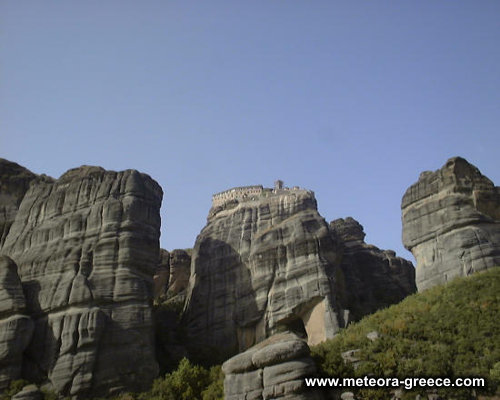The Holy Monastery of Varlaam is opposite the Great Meteoro. Its founder is the hermit Varlaam in the middle of 14th century. Later, it was renovated by the brothers Theophanis and Nektarios Apsaras from Ioannina.
The catholic of the Holy Convent is in the honour of All Saints and was built by the monks and brothers Theophanis and Nektarios in 1541-1544. The frescos of the catholic are created mainly by Fragos Katelanos from Thebe.

There is also the chapel of the Three Hierarchs built upon the first small church that the hermit Varlaam built. Important constructions are the old “trapeza”(dining hall), the Centre (kitchen) and the Old Age Home (hospital). Moreover, at the holy convent there is a remarkable and rich collection of manuscripts, icons and sacred heir-looms.
In 1350 a daring ascetic named Varlaam ascended to the rock. The monastery was named after him. He built three churches, a small cell and a water tank. After his death the rock remained abandoned for about 200 years. In 1517/1518 the two founders of the church, the priest-monks Theophanes and Nektarios Apsarades reached the rock. They were two rich brothers from Ioanina. They found the rock of Varlaam abandoned, so they started to construct the first buildings from the beginning. They renovated the little church of the Three Hierarchs and they erected the tower. They also built (in 1541/1542) the central church of the monastery (the katholikon) dedicated to All Saints. The transportation of the materials lasted 22 years and the building only 20 days. Up to the 16th century the presence of the monks was constant. From the early part of the 17th century onwards, only a few monks remained. Since then, the decline starts.
Since 1350, the ascent to the monastery was made by wooden ladders, each of which had about 25 rungs. The ladders were hanging from the rock with the help of pegs on the north side of the church and a gap was created between them. The monks often had to jump from one ladder to another risking even their own lives. This difficulty was due to the peculiarity and the morphology of the rocks. There were about 4 or 5 ladders consisting of 95 rungs at maximum. In 1517/1518, the founders who built the tower of the monastery -as it is mentioned in the first question- reached the rock. Then, the monks and materials were hoisted by hand in a rope net. From the early part of the 19th century, they created steps carved in the rock with a bridge between them, which have been altered a lot of times. Nowadays, objects are hoisted electrically.
In the time of the Holy founders, Theophanes and Nektarios, and during the 16th century about 35 monks lived in the monastery. From the 17th century onwards the decline starts and it lasts up to 1961. At that time, a monastic community whose abbot was the present Metropolitan of Piraeus, Kalinikos reached the rock. He was accompanied by the present Metropolitan of Kitrus and Katerini, Agathonikos, the present archbishop of Athens and Greece, Christodoulos and the present abbot archimandrite Isidorus Tsiatas. Today the monastic community consists of 7 monks.
